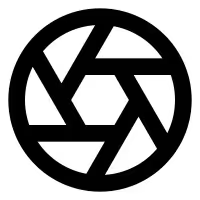OnePageCRM Alternatives
Explore 10 alternatives to OnePageCRM. This guide offers a detailed comparison of features, pricing, and use cases to inform your choice.
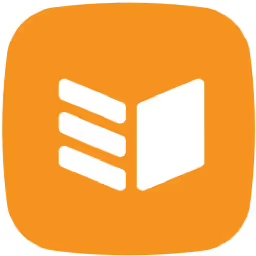
OnePageCRM is a tool many sales teams choose for good reasons. Its focus on simplicity and next-action sales helps keep reps on track. If you need a straightforward system to manage contacts and follow-ups without extra complexity, it performs very well.
However, some users find it lacks advanced reporting or has integration limits as their teams grow. We've identified the best alternatives and analyzed their pros and cons against OnePageCRM, using G2 reviews, to help you shortlist options for a deeper review. Let's get started.
What About Digital Workers? Meet 11x
For teams interested in digital workers for sales, 11x is a platform to review. It provides autonomous agents to handle specific sales tasks. This lets your sales reps focus on activities that require a human touch, like building relationships and closing deals.
At 11x, we provide a GTM platform where AI agents manage your sales process. Our agent, Alice, finds prospects, runs outreach on email and LinkedIn, and updates your CRM. A second agent, Julian, qualifies inbound leads and books meetings.
This approach means you do not need separate solutions for data enrichment, outreach, or email warmup. We unify these functions into a single platform.
OnePageCRM Alternatives
Here we review the top alternatives to OnePageCRM in detail. We analyze each tool's pricing, main features, and its specific advantages and drawbacks compared to OnePageCRM.
1) Salesforce Sales Cloud
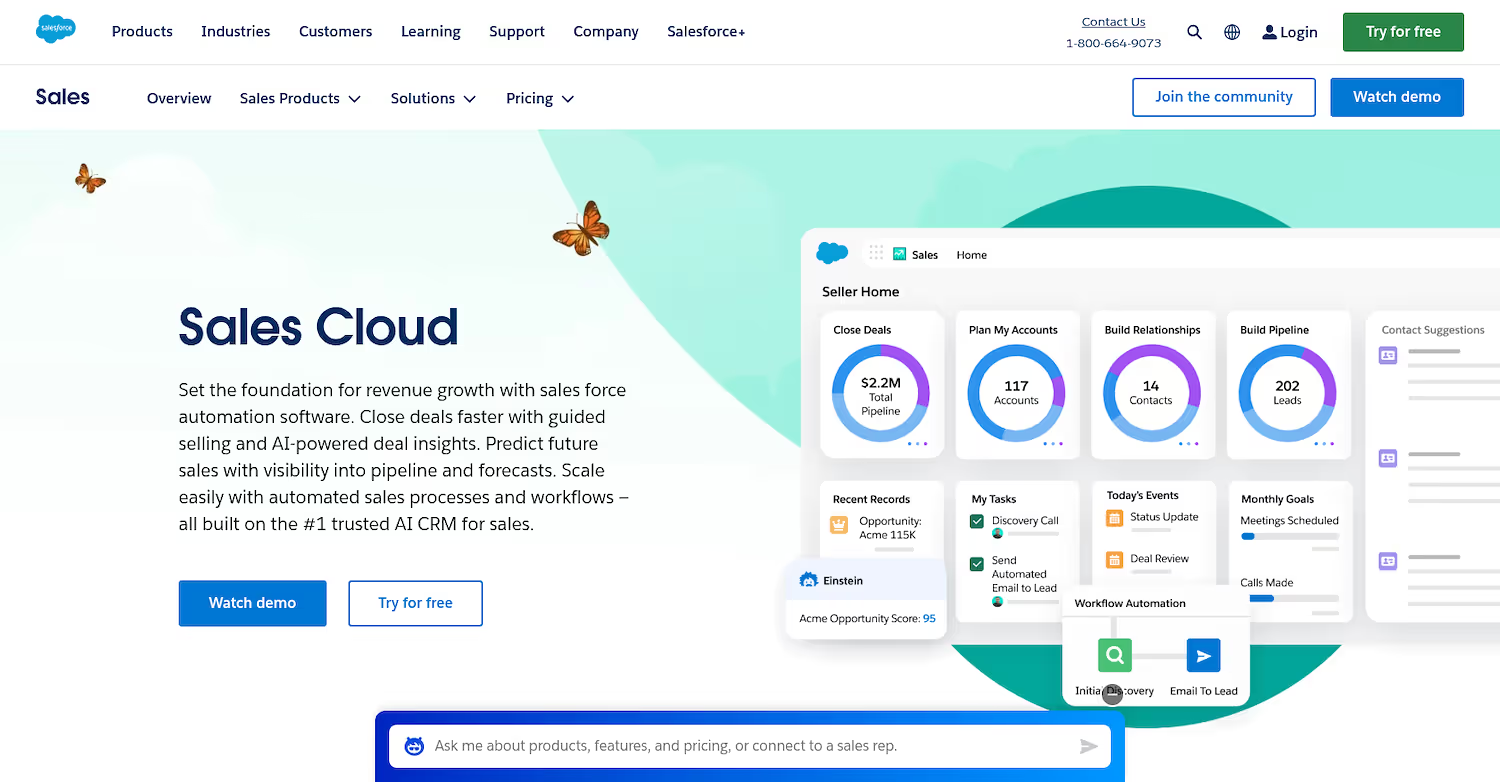
Salesforce Sales Cloud is a sales automation platform on the Salesforce CRM. It uses AI to guide sellers, unify customer data, and automate workflows. The system provides real-time visibility into pipelines and forecasts and serves as a single source of truth for sales activities.
It scales from small businesses to large enterprises and helps prioritize leads, guide deals, and automate quote generation.
Salesforce Sales Cloud's Main Features
- Automates complex processes and territory assignments with a drag-and-drop flow builder.
- Generates templated quotes that sync to opportunities and automates approval flows.
- Provides a consolidated pipeline view with change-over-time charts and AI-driven deal insights.
- Offers real-time, customizable forecasts with capabilities for tracking trends.
Salesforce Sales Cloud vs. OnePageCRM
Average Review Score: 4.4/5 stars based on 23,364 G2 reviews.
- Salesforce Sales Cloud provides advanced reporting and analytics with customizable dashboards. This offers a deeper view into sales performance compared to the more direct reporting in OnePageCRM.
- It offers more extensive automation capabilities, including a drag-and-drop builder for complex workflows. OnePageCRM's automation, in comparison, focuses on next-action reminders.
- The platform includes features like automated quote generation and revenue lifecycle management. These tools support more complex sales cycles than OnePageCRM's contact-focused system.
- This tool connects with a vast ecosystem of third-party applications via its AppExchange. This provides more integration flexibility than OnePageCRM's curated list of integrations.
Potential Downsides of Salesforce Sales Cloud
- Some users find Salesforce Sales Cloud complex to learn due to its extensive features. In contrast, OnePageCRM provides a straightforward design focused on immediate action, which can be easier for teams to adopt.
- The tool's pricing can be a significant investment, especially for smaller teams. OnePageCRM offers a more budget-friendly price point, making it an accessible option for businesses with limited resources.
- Its extensive feature set might be overwhelming for teams that need a simple, action-oriented CRM. OnePageCRM's design centers on a "next action" methodology, which keeps sales reps focused on immediate follow-up tasks.
Pricing and Budget Considerations
Salesforce Sales Cloud plans start at $25 per user per month and increase to $330 for the Unlimited Edition. This cost is higher than OnePageCRM, which is a more budget-friendly option, but it covers Salesforce's extensive features for complex sales cycles.
2) HubSpot CRM
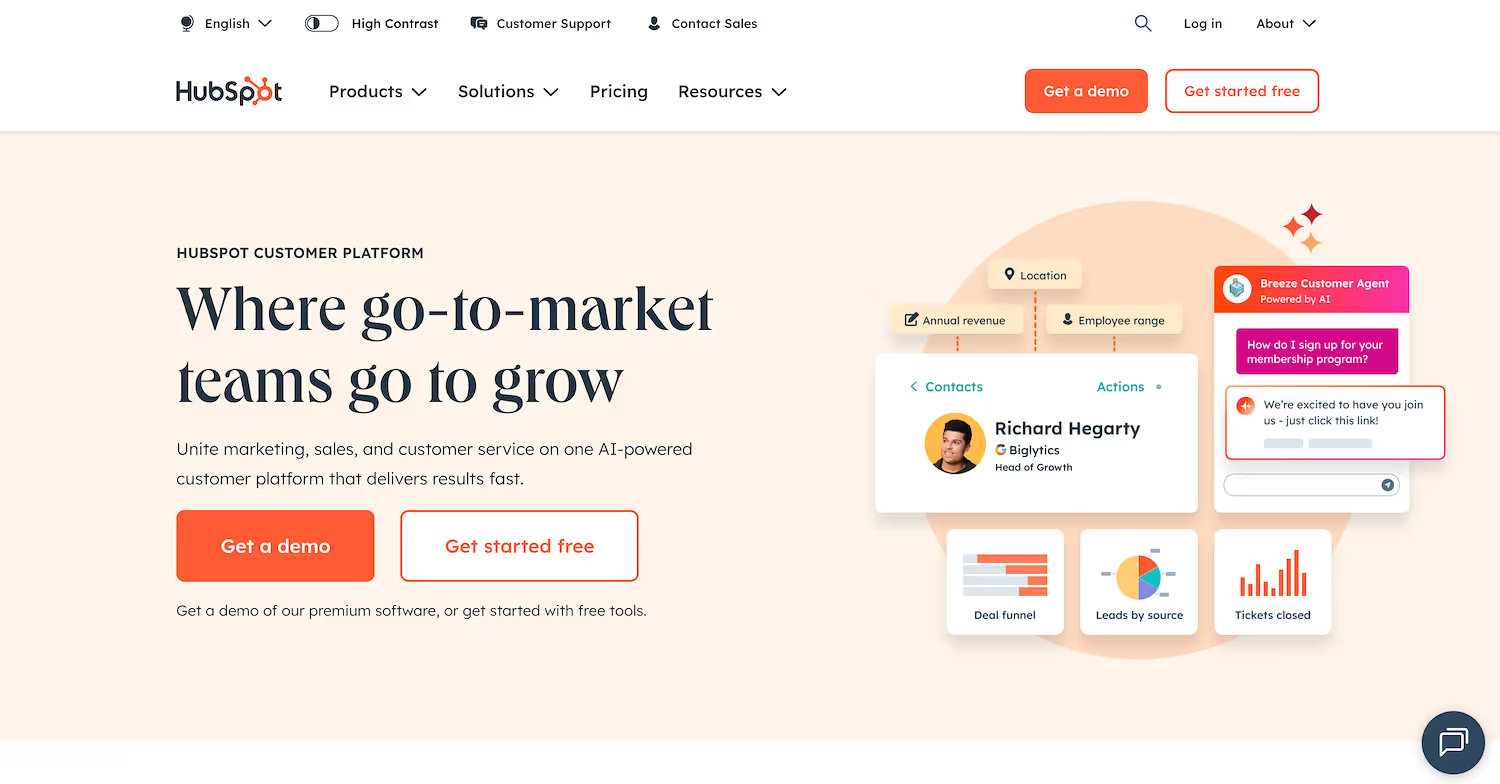
HubSpot CRM is a platform that powers the HubSpot suite of tools. It provides a central database for marketing, sales, and service teams to manage customer interactions. The system tracks contacts, deals, and tasks in one place.
This unified view helps align teams and gives a complete picture of the customer journey. The platform is designed for businesses of all sizes to organize and track their customer relationships.
HubSpot CRM's Main Features
- Tracks all customer interactions, from website visits to support tickets, in one timeline.
- Automates email follow-ups and lead nurturing with customizable sequences.
- Includes a meeting scheduler that syncs with Google or Office 365 calendars.
- Offers built-in reporting dashboards to monitor the sales pipeline and team performance.
HubSpot CRM vs. OnePageCRM
Average Review Score: 4.4/5 stars based on 12,407 G2 reviews.
- HubSpot CRM has marketing automation features to manage email campaigns. This provides a more integrated approach than OnePageCRM, which centers on sales follow-up actions.
- It offers a unified platform that connects sales, marketing, and service data. This creates a complete customer view, unlike OnePageCRM's design around individual sales tasks.
- The tool provides a free CRM plan, so teams can start without a budget. This differs from OnePageCRM, which requires a paid subscription for all its features.
- HubSpot connects to a large ecosystem of third-party apps via its marketplace. This offers more integration options compared to OnePageCRM's curated list.
- This platform includes built-in customer support features like case management. It allows teams to handle service issues in the same system, a function not present in OnePageCRM's sales-focused design.
Potential Downsides of HubSpot CRM
- Some teams find HubSpot's all-in-one system complex compared to OnePageCRM's simple, action-focused design. OnePageCRM shows only the next required action for a contact, which can prevent sales reps from feeling overwhelmed.
- While HubSpot has a free plan, access to advanced sales automation and reporting tools requires expensive subscriptions. OnePageCRM includes its full feature set in one plan, which can make budgeting more predictable.
- The tool's features span marketing, sales, and service, which may be too broad for a dedicated sales team. OnePageCRM is built specifically for sales activities, offering a more focused user experience without extra modules.
Pricing and Budget Considerations
HubSpot offers a free CRM and paid plans from $20 to $150 per user monthly. This provides a no-cost entry point, unlike OnePageCRM's single paid plan, but can become more expensive for advanced features.
3) Pipedrive

Pipedrive is a web-based CRM platform built for sales-driven teams to track pipelines and manage deals. It uses visual, kanban-style pipelines and provides workflow automation with AI-powered guidance. The system helps centralize customer data and communications in one workspace.
It automates lead nurturing and follow-up tasks to save administrative hours. Teams can also generate real-time sales forecasts and performance dashboards for management.
Pipedrive's Main Features
- Provides visual, kanban-style drag-and-drop pipelines with custom stages and fields.
- Includes an AI Sales Assistant that offers deal-win predictions and daily insights.
- Automates lead nurturing through multi-step email sequences and two-way email sync.
- Generates real-time dashboards and custom reports for revenue forecasting and goal tracking.
Pipedrive vs. OnePageCRM
Average Review Score: 4.3/5 stars based on 2,573 G2 reviews.
- Pipedrive provides a visual, drag-and-drop sales pipeline, offering a complete overview of deals. This differs from OnePageCRM's list-based, next-action focus.
- An included AI Sales Assistant predicts deal outcomes, adding a layer of data-driven guidance not present in OnePageCRM's task system.
- The platform automates multi-step email sequences for lead nurturing. This is a more hands-off approach compared to OnePageCRM's manual follow-up model.
- Users get more advanced reporting with customizable dashboards for revenue forecasting, offering deeper analytics than the direct reports in OnePageCRM.
Potential Downsides of Pipedrive
- Pipedrive's visual pipeline can sometimes feel complex for teams that prefer a simple, task-list approach. OnePageCRM, in comparison, focuses only on the next action for each contact, which keeps sales reps centered on immediate follow-ups.
- Some users find the separation between contacts and companies in the tool a bit cumbersome. This is different from OnePageCRM's design, which centers everything around a single contact list to simplify data management for sales reps.
- Access to certain features, like email sync, requires a subscription to Pipedrive's higher-priced plans. This contrasts with OnePageCRM, where all features are included in one plan, which can make budget planning more straightforward for some teams.
Pricing and Budget Considerations
Pipedrive uses a tiered pricing model, with plans from $24 to $99 per user monthly. This structure offers flexibility but contrasts with OnePageCRM's single, all-inclusive plan, which can be more straightforward for budget planning as all features are included from the start.
4) Zoho CRM
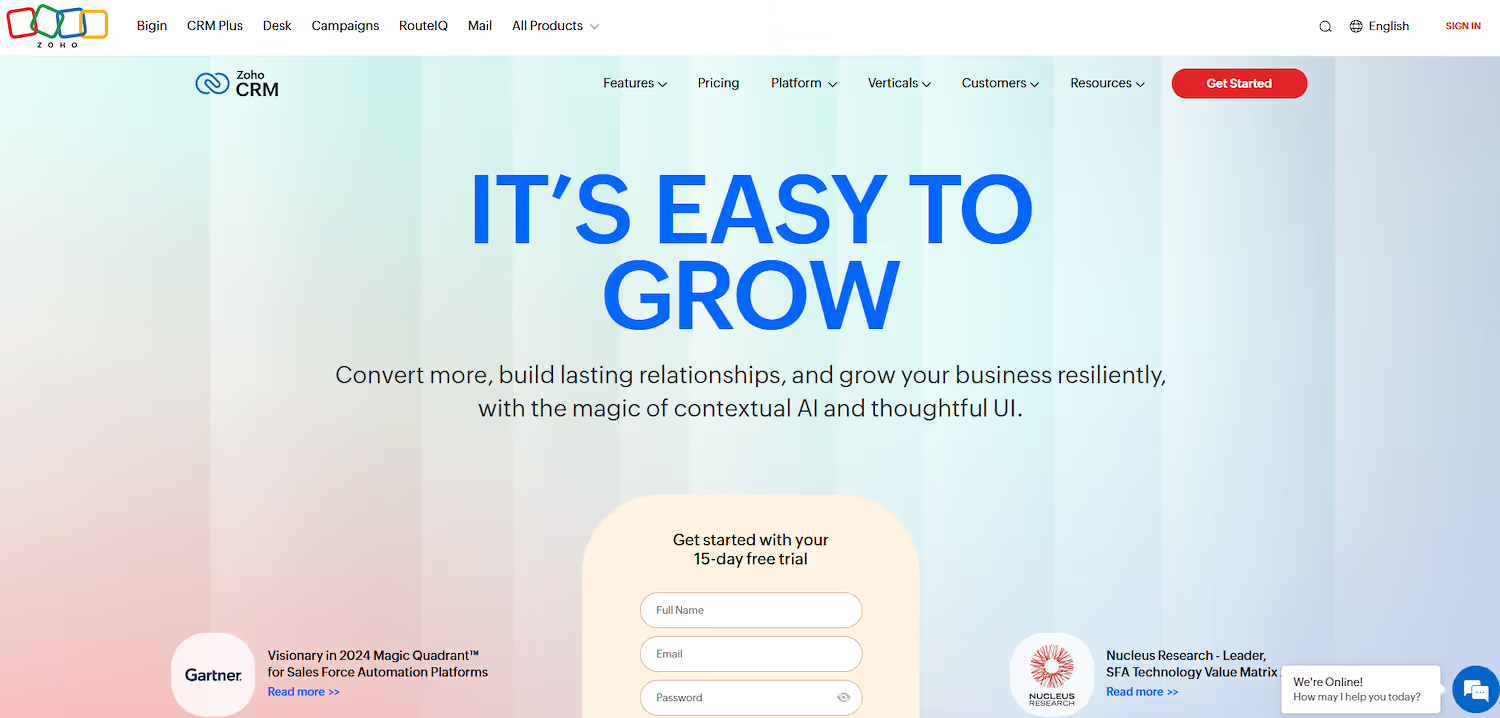
Zoho CRM is a platform for customer relationship management. It unifies sales, marketing, and support activities to help businesses manage the full customer lifecycle. The system offers tools for lead management through after-sales service.
It supports omnichannel communication so teams can connect with customers on different channels. The platform serves multiple industries, including real estate, financial services, and retail, with specific business needs.
Zoho CRM's Main Features
- Offers omni-channel communication for real-time conversations with customers across web, phone, email, and social media.
- Includes an AI assistant, Zia, that provides email rewriting, anomaly detection, and predictive insights.
- Provides a drag-and-drop design studio, Canvas, to customize the user interface without writing code.
- Creates dedicated collaborative work areas called Teamspaces, so each department sees only the data it needs.
Zoho CRM vs. OnePageCRM
Average Review Score: 4.1/5 stars based on 2,820 G2 reviews.
- Zoho CRM supports omnichannel communication for customer interactions across phone, email, and social media. This is a broader approach compared to OnePageCRM's focus on next-action sales follow-ups.
- It includes an AI assistant, Zia, that provides predictive insights. This adds a layer of automation different from OnePageCRM's manual, action-focused system.
- The platform offers a drag-and-drop design studio, Canvas, to customize the user interface. This level of personalization differs from OnePageCRM's straightforward, fixed layout.
- This tool unifies sales, marketing, and support functions in one system. This is different from OnePageCRM, which is built specifically for sales activities.
Potential Downsides Of Zoho CRM
- Some users find the extensive feature set creates a steep learning curve. In contrast, OnePageCRM has a simple, action-focused design that sales reps can adopt quickly with minimal onboarding.
- The tool's all-in-one system includes marketing and service modules, which might be too broad for a dedicated sales team. OnePageCRM provides a more focused experience built only for sales activities.
- Its interface can sometimes feel cluttered due to the number of options available. This is different from OnePageCRM, which uses a clean, list-based view centered on the next action to prevent information overload.
Pricing and Budget Considerations
Zoho CRM provides a free plan and paid tiers from $14 to $40 per user monthly, offering a flexible entry point. This contrasts with OnePageCRM's single, all-inclusive plan, which can make budgeting more predictable as all features are included.
5) Insightly
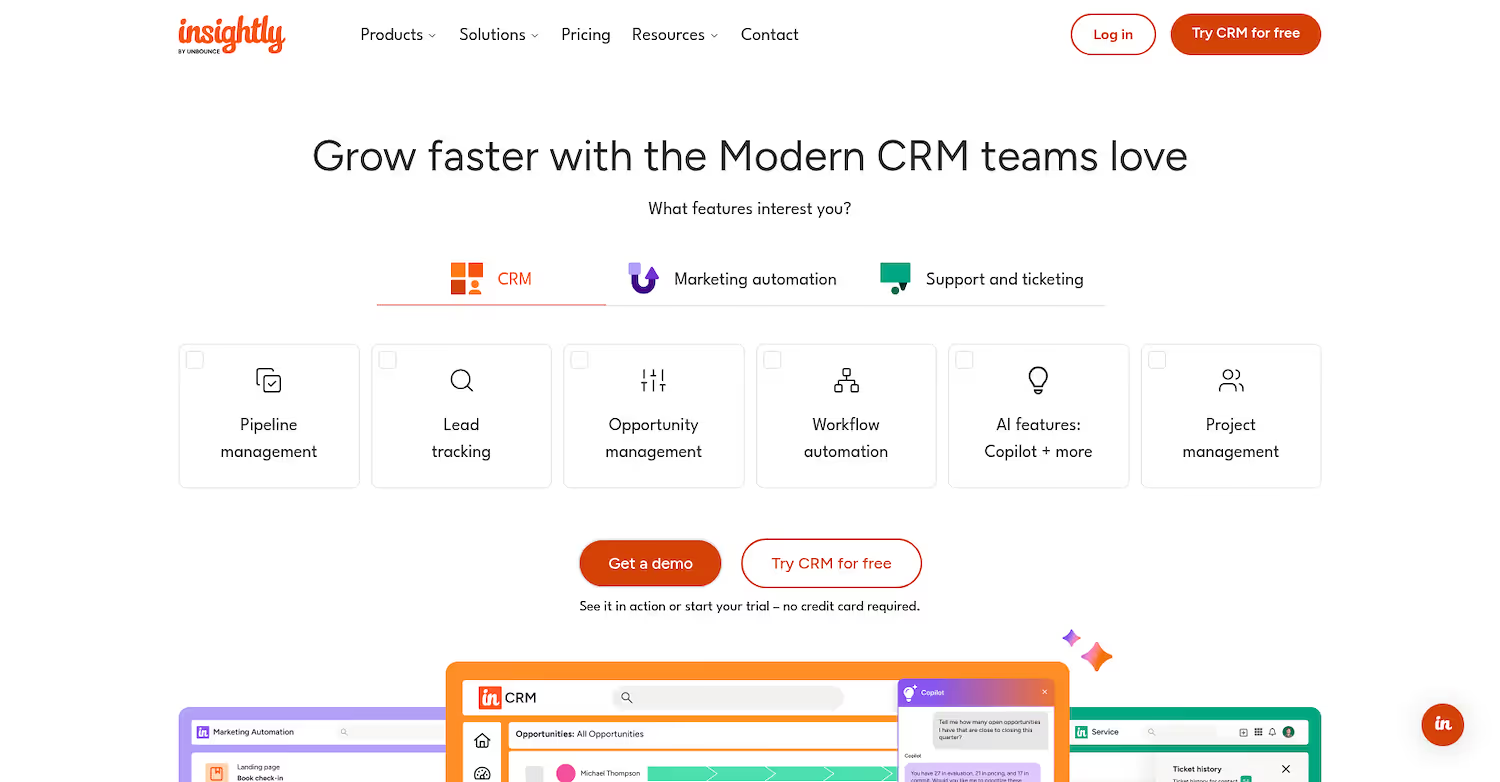
Insightly is a unified CRM platform that connects sales, marketing, and service teams around a central customer view. The system helps businesses manage data and interactions throughout the customer lifecycle.
It also includes project management functions. This allows teams to track work and deliverables after a sale closes, which connects the sales process to project execution.
Insightly's Main Features
- Designs multi-step customer journeys with a drag-and-drop builder and A/B testing.
- Offers customer self-service portals and knowledge bases for support and ticketing.
- Connects to other apps with a no-code integration hub called AppConnect.
- Manages post-sale work with custom objects, fields, and project stages.
Insightly vs. OnePageCRM
Average Review Score: 4.2/5 stars based on 922 G2 reviews.
- Insightly includes project management to track work after a sale. This connects sales to project delivery, a function not present in OnePageCRM's sales-focused system.
- The platform provides a journey builder for creating multi-step marketing campaigns. This offers more advanced automation than OnePageCRM's next-action sales reminders.
- It has built-in tools for customer support, like self-service portals and knowledge bases. This unifies sales and service, while OnePageCRM is designed only for sales tasks.
- This tool connects to over 500 apps through its AppConnect hub, offering more integration options than OnePageCRM's curated list.
Potential Downsides Of Insightly
- Insightly's unified system for sales, marketing, and service can feel complex for a dedicated sales team. In contrast, OnePageCRM provides a simple, action-focused design centered on the next follow-up task.
- Some users find its broad features, like project management, are too much for a pure sales role. OnePageCRM is different because it is built only for sales activities and offers a more focused experience.
- Its interface can sometimes feel cluttered due to the number of options. OnePageCRM uses a clean, list-based view that shows only the next action, which helps prevent information overload.
Pricing and Budget Considerations
Insightly offers tiered plans from $29 to $99 per user monthly, billed annually. This model differs from OnePageCRM's single, all-inclusive plan. Insightly's tiers provide flexibility for growing teams, whereas OnePageCRM offers predictable budgeting with all features included in one price.
Try Digital Workers with 11x
For teams interested in digital workers for sales, 11x presents a different path. Our platform uses AI agents for prospecting, outreach, and lead qualification. This allows your reps to focus on deal closure and customer relationships. Book a demo to see how it works.
With 11x, we use AI to run your sales playbook. Alice finds accounts, enriches data, and drives outreach. Julian handles calls, qualifies prospects, and schedules meetings. Our platform includes everything from intent signals to email warmup, so you do not need extra tools.
Book a demo to see 11x in action.
6) Copper
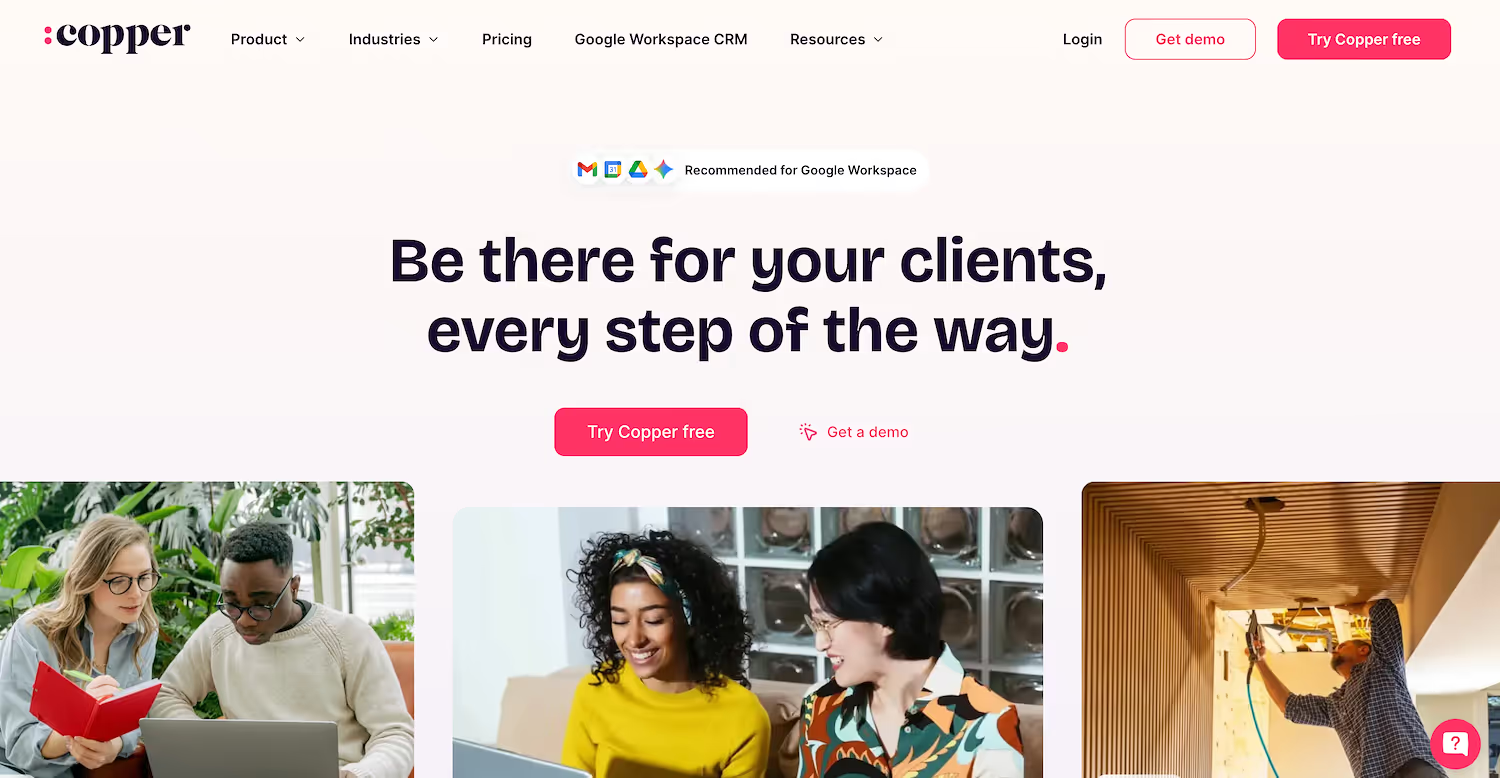
Copper is a CRM platform for businesses that use Google Workspace. It integrates into Gmail, so teams manage contacts and sales leads from their inbox. The system automates data entry and helps organize customer information without complex administration.
It is built to manage sales pipelines and track relationships. This tool is the only CRM recommended by Google for users of its productivity suite.
Copper's Main Features
- Integrates directly into Gmail and Google Workspace, allowing users to manage leads and tasks from their inbox.
- Provides customizable, drag-and-drop pipelines to track deals with features like probability weighting and value sorting.
- Manages post-sale work by converting closed deals into project boards with assigned tasks for team collaboration.
- Automates email outreach with personalized series and messages that are triggered by changes in the pipeline stage.
Copper vs. OnePageCRM
Average Review Score: 4.5/5 stars based on 1,139 G2 reviews.
- Copper integrates directly into Gmail, so users manage leads from their inbox. This is different from OnePageCRM, which operates as a separate application.
- It includes project management features to handle post-sale tasks. This connects sales to delivery, a function not found in OnePageCRM's sales-focused design.
- The tool automates email sequences based on pipeline stage changes. This offers a different approach than OnePageCRM's manual next-action reminders for follow-ups.
- Its system automatically updates contact information from Gmail and Google Calendar. This reduces manual data entry compared to the contact management process in OnePageCRM.
Potential Downsides Of Copper
- Copper's design centers on Google Workspace, which can be a limitation for teams that use other email systems. In contrast, OnePageCRM is a standalone application that offers flexibility regardless of the email provider a team uses.
- Some users find that its project management features can complicate the workflow for a pure sales role. OnePageCRM maintains a strict focus on the next sales action, which helps keep reps centered on follow-up tasks without extra modules.
- Access to certain features in Copper may require a subscription to a higher-priced plan. This is different from OnePageCRM, where all features are included in one plan, which can make budget planning more predictable for some teams.
Pricing and Budget Considerations
Copper offers tiered plans from $23 to $99 per user monthly. This model provides flexibility but contrasts with OnePageCRM's single, all-inclusive plan, which can offer more predictable budgeting as all features are included from the start.
7) Freshsales

Freshsales is a CRM platform that offers sales force automation. It unifies sales and marketing teams with a single customer view to manage contacts and deals. The system supports communication across multiple channels and uses AI to automate tasks and provide sales insights.
Freshsales's Main Features
- Includes an AI assistant, Freddy, that provides deal recommendations, drafts emails, and identifies pipeline bottlenecks.
- Supports omnichannel engagement, allowing teams to interact with prospects on their preferred channels with full context and intent scoring.
- Offers kanban-style deal pipelines with drag-and-drop cards to organize and advance deals through stages.
- Provides a suite option that combines sales and marketing functions into a single, unified CRM.
How Freshsales Compares To OnePageCRM
Average Review Score: 4.5/5 stars based on 1,224 G2 reviews.
- Freshsales uses its AI assistant, Freddy, to suggest deals and draft emails. This provides predictive guidance, which is different from OnePageCRM's manual, task-based system.
- The tool supports communication across phone, email, and social media. This is a broader approach to customer engagement compared to OnePageCRM's focus on next-action sales tasks.
- It offers a suite that combines sales and marketing functions into one platform. This unified system is different from OnePageCRM, which is designed specifically for sales activities.
- A visual, kanban-style pipeline in Freshsales helps organize deals. This offers a different perspective from OnePageCRM's list-based view, which centers on the next action for each contact.
Potential Downsides Of Freshsales
- Some users find the combined sales and marketing suite in Freshsales can be too broad. This is different from OnePageCRM, which is built only for sales activities and provides a more focused user experience.
- The tool's AI assistant and omnichannel features can introduce a learning curve for some teams. In comparison, OnePageCRM's simple, action-driven design allows for faster team adoption with minimal training.
- Freshsales uses a visual pipeline to manage deals, which some users might find complex. OnePageCRM's workflow centers on a simple action list, which keeps reps focused on the immediate next step for each contact.
Pricing and Budget Considerations
Freshsales offers tiered plans from $9 to $59 per user monthly, providing a low-cost entry point. This model contrasts with OnePageCRM's single, all-inclusive plan, which can offer more predictable budgeting as all features are included from the start.
8) Agile CRM
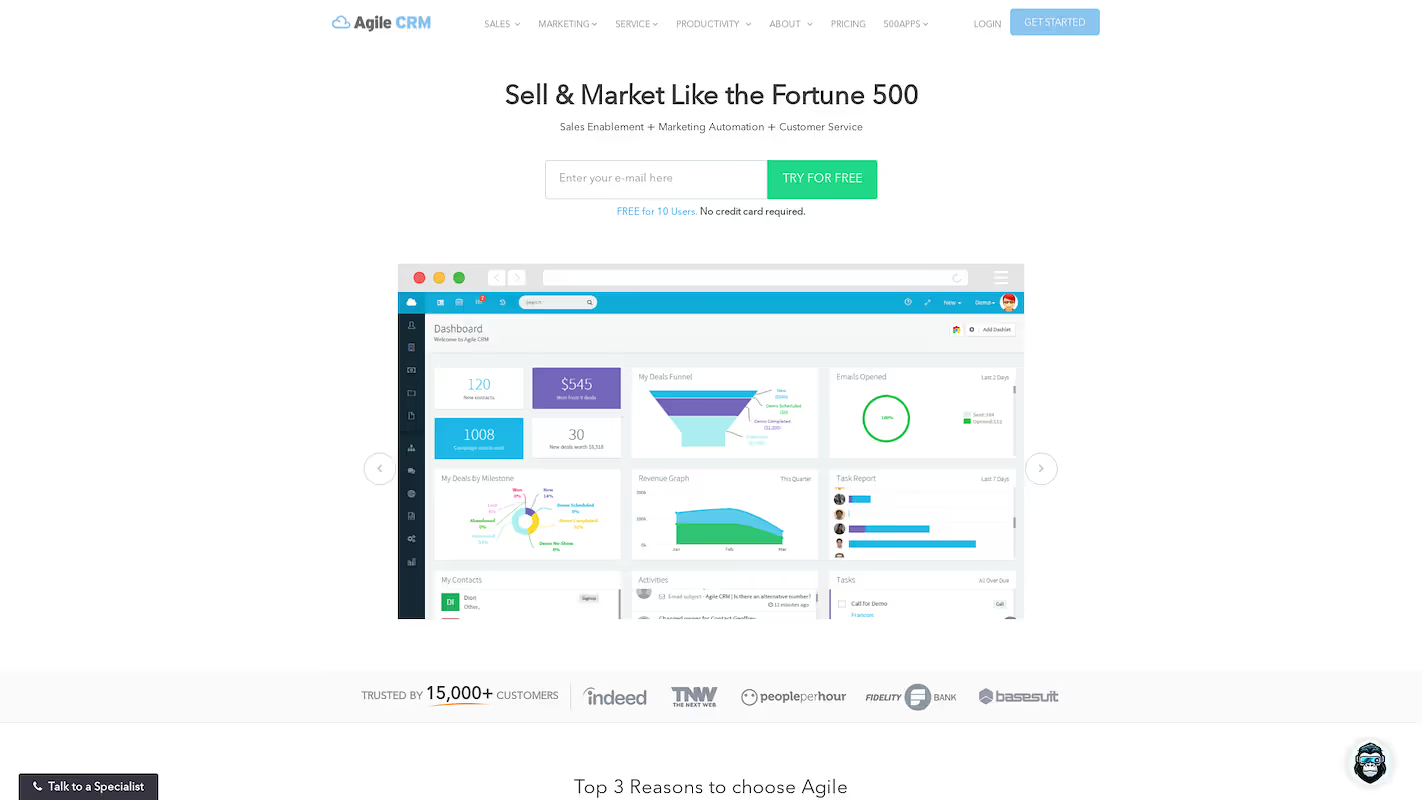
Agile CRM is an all-in-one platform that combines sales, marketing, and service automation. It provides tools to manage contacts, track deals, and run marketing campaigns from a single dashboard. The system is built for small to medium-sized businesses to help them manage the full customer lifecycle.
Agile CRM's Main Features
- Automates marketing and sales processes with a drag-and-drop editor.
- Includes a helpdesk with case management and a customer support portal.
- Enables multi-channel communication to call, email, or tweet from a single page.
- Provides web analytics to monitor customer behavior and convert website visitors into leads.
Agile CRM vs. OnePageCRM
Average Review Score: 4.0/5 stars based on 352 G2 reviews.
- Agile CRM includes marketing automation with a drag-and-drop builder. This is different from OnePageCRM, which centers on manual sales follow-up actions.
- It provides a built-in helpdesk for customer support. This unifies sales and service, while OnePageCRM is designed only for sales tasks.
- The tool offers web analytics to monitor customer behavior on a website. This provides lead intelligence that is not available in OnePageCRM's contact-focused system.
- This platform supports multi-channel communication from a single contact page, a broader approach compared to OnePageCRM's focus on next-action sales tasks.
Potential Downsides Of Agile CRM
- Some users find Agile CRM's all-in-one system for sales, marketing, and service can be complex. In contrast, OnePageCRM provides a simple design focused only on sales activities, which can help teams adopt it faster.
- The tool's interface can sometimes feel cluttered due to the number of options available. OnePageCRM uses a clean, list-based view that shows only the next action, which helps prevent information overload for sales reps.
- Its broad features, like the built-in helpdesk, might be too much for a pure sales role. OnePageCRM is different because it is built only for sales follow-ups and offers a more focused user experience without extra modules.
Pricing and Budget Considerations
Agile CRM offers a free plan and paid tiers from $8.99 to $47.99 per user monthly. This tiered model provides a flexible entry point, unlike OnePageCRM's single, all-inclusive plan. OnePageCRM's approach can make budgeting more predictable since all features are included from the start.
9) Nutshell CRM
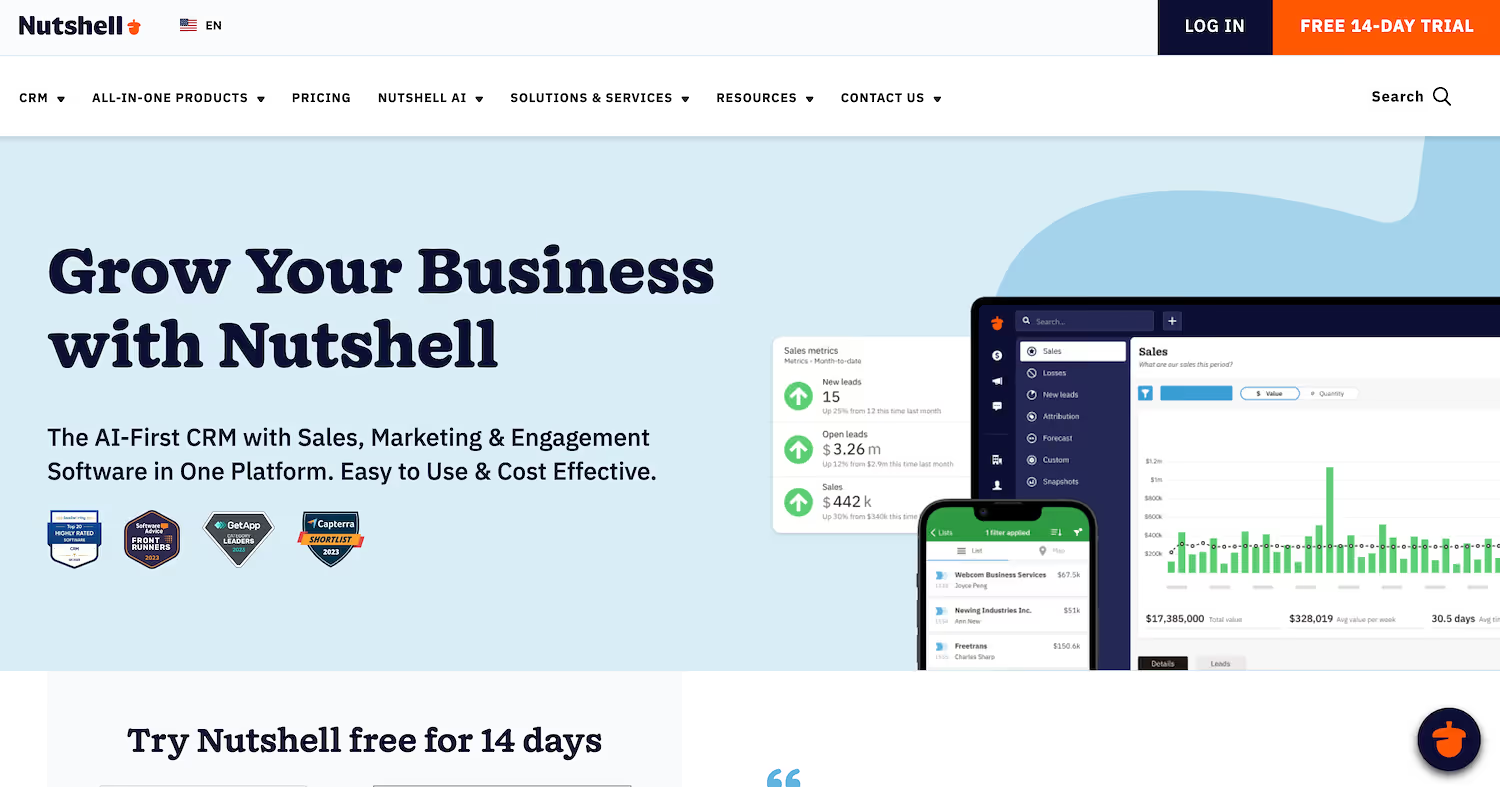
Nutshell CRM is a customer relationship management platform designed for sales teams. It provides tools to manage contacts, track deals, and organize sales processes in one place. The system helps businesses centralize customer data and communications to support their sales efforts.
Nutshell CRM's Main Features
- Automates marketing processes and supports the creation of email campaigns and landing pages.
- Includes a customer support portal and a knowledge base for service management.
- Manages leads through web chat and text messaging for customer engagement.
- Provides user, role, and access management to control data visibility.
Nutshell CRM vs. OnePageCRM
Average Review Score: 4.3/5 stars based on 1,273 G2 reviews.
- Nutshell CRM includes marketing automation to create email campaigns and landing pages. This is different from OnePageCRM, which centers on manual sales follow-up tasks.
- It provides a customer support portal and a knowledge base for service management. This unifies sales and support, while OnePageCRM is designed only for sales activities.
- The tool allows lead engagement through web chat and text messaging. This offers more communication channels compared to OnePageCRM's system, which focuses on email and call follow-ups.
- This platform offers detailed user, role, and access management to control data visibility. This provides more granular control over team permissions than the user structure in OnePageCRM.
Potential Downsides Of Nutshell CRM
- Nutshell CRM combines sales, marketing, and service tools, which can create a complex system for a dedicated sales team. This is different from OnePageCRM's design, which focuses only on the next sales action to keep reps on task.
- The tool's interface includes many options for marketing and support, which some users might find cluttered. In comparison, OnePageCRM provides a clean, list-based view that shows only the next required follow-up, which can help prevent information overload.
- Its built-in features for customer support, like a helpdesk portal, may be unnecessary for a pure sales role. OnePageCRM is different because it is built only for sales follow-ups and offers a more focused user experience without extra modules.
Pricing and Budget Considerations
Nutshell offers tiered plans from $13 to $59 per user monthly. This model provides flexibility but contrasts with OnePageCRM's single, all-inclusive plan, which can offer more predictable budgeting as all features are included from the start.
10) Close CRM
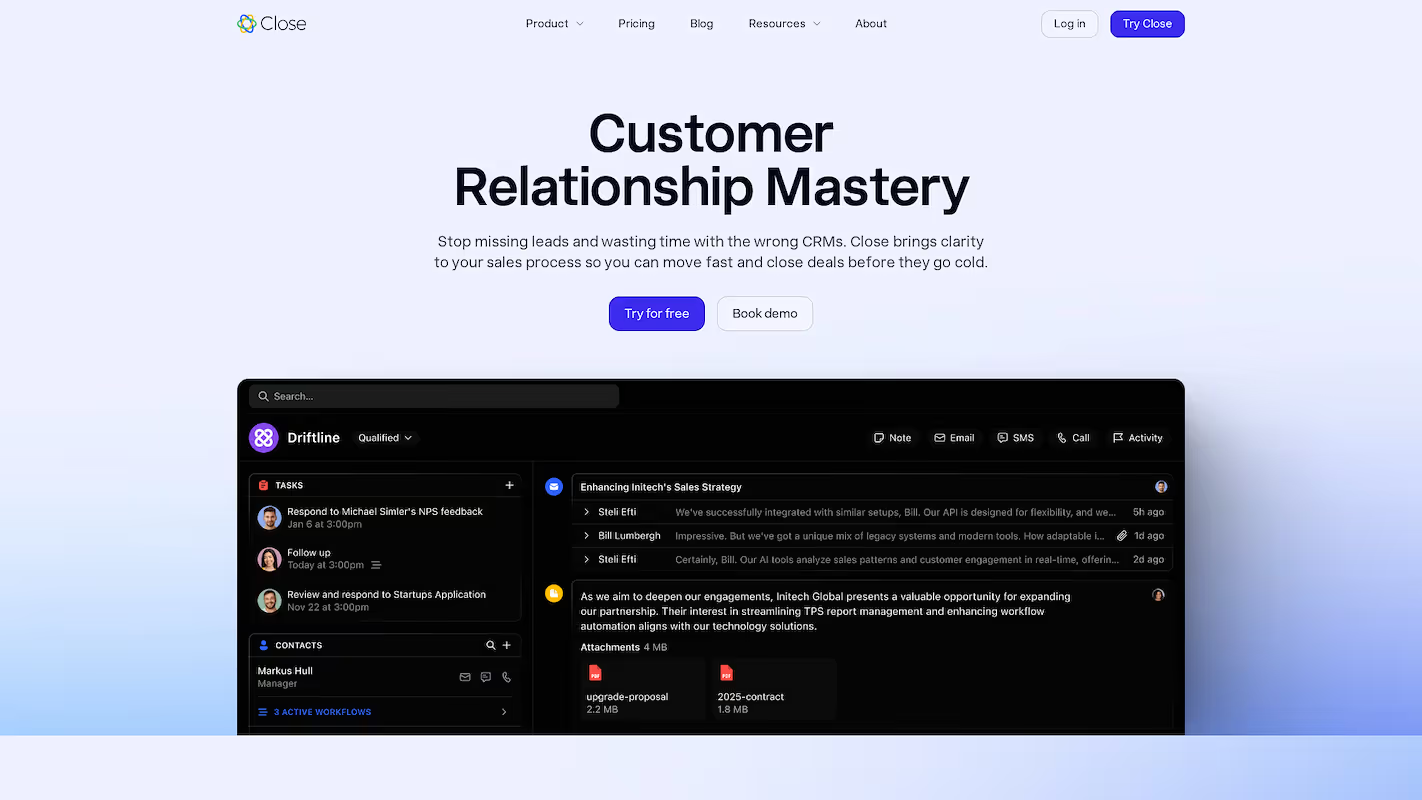
Close CRM is a sales engagement platform for small and medium-sized businesses that combines communication tools like voice calls, email, and SMS. It allows sales teams to manage outreach and follow-ups from a single interface, so all customer interactions stay organized in one place.
Close CRM's Main Features
- Combines CRM functions with built-in calling, email, and SMS to manage communications in one place.
- Includes an AI Sales Assistant for sales suggestions and built-in coaching tools.
- Provides a unified inbox view to help sales reps manage their most pressing tasks.
- Uses workflow automation to ensure leads are followed up on and no opportunities are missed.
How Close CRM Compares To OnePageCRM
Average Review Score: 4.7/5 stars based on 1,812 G2 reviews.
- Close CRM combines built-in calling, email, and SMS into a single platform. This is different from OnePageCRM, which focuses on tracking the next follow-up action instead of providing integrated communication tools.
- The platform includes an AI Sales Assistant that provides sales suggestions. This adds a layer of automated guidance not found in OnePageCRM's manual, task-oriented system.
- It provides a unified inbox that helps sales reps manage their most pressing tasks in one central view. This contrasts with OnePageCRM's list-based approach, which organizes work around individual contacts.
- This tool uses workflow automation to ensure leads receive a follow-up. This is a more automated approach compared to OnePageCRM's system of manual reminders for each next action.
Potential Downsides Of Close CRM
- Close CRM's unified inbox combines all communications, which some teams might find complex. In comparison, OnePageCRM uses a next-action design that keeps reps focused only on the next follow-up task for each contact, which can simplify the workflow.
- The platform's design as an all-in-one sales engagement tool may be too broad for some teams. OnePageCRM, in contrast, provides a more focused experience built specifically for contact management and sales follow-ups, without the integrated communication tools.
- Some users report a learning curve with Close CRM, especially for setup and role assignments. This is different from OnePageCRM, which has a straightforward design that teams can often adopt with minimal training due to its focus on a single action list.
Pricing and Budget Considerations
Close CRM offers tiered plans from $9 to $139 per user monthly. This model provides flexibility but contrasts with OnePageCRM's single, all-inclusive plan, which can offer more predictable budgeting as all features are included from the start.
Which One Should You Go With?
The right OnePageCRM alternative depends on many variables, including your team's size, sales process, and budget. This guide reviewed several options to help you create a shortlist for a more detailed evaluation.
If your goal is sales task automation rather than management, review 11x. Our platform provides AI agents for prospecting, outreach, and lead qualification. This lets your sales team focus on deal closure and relationship development.



